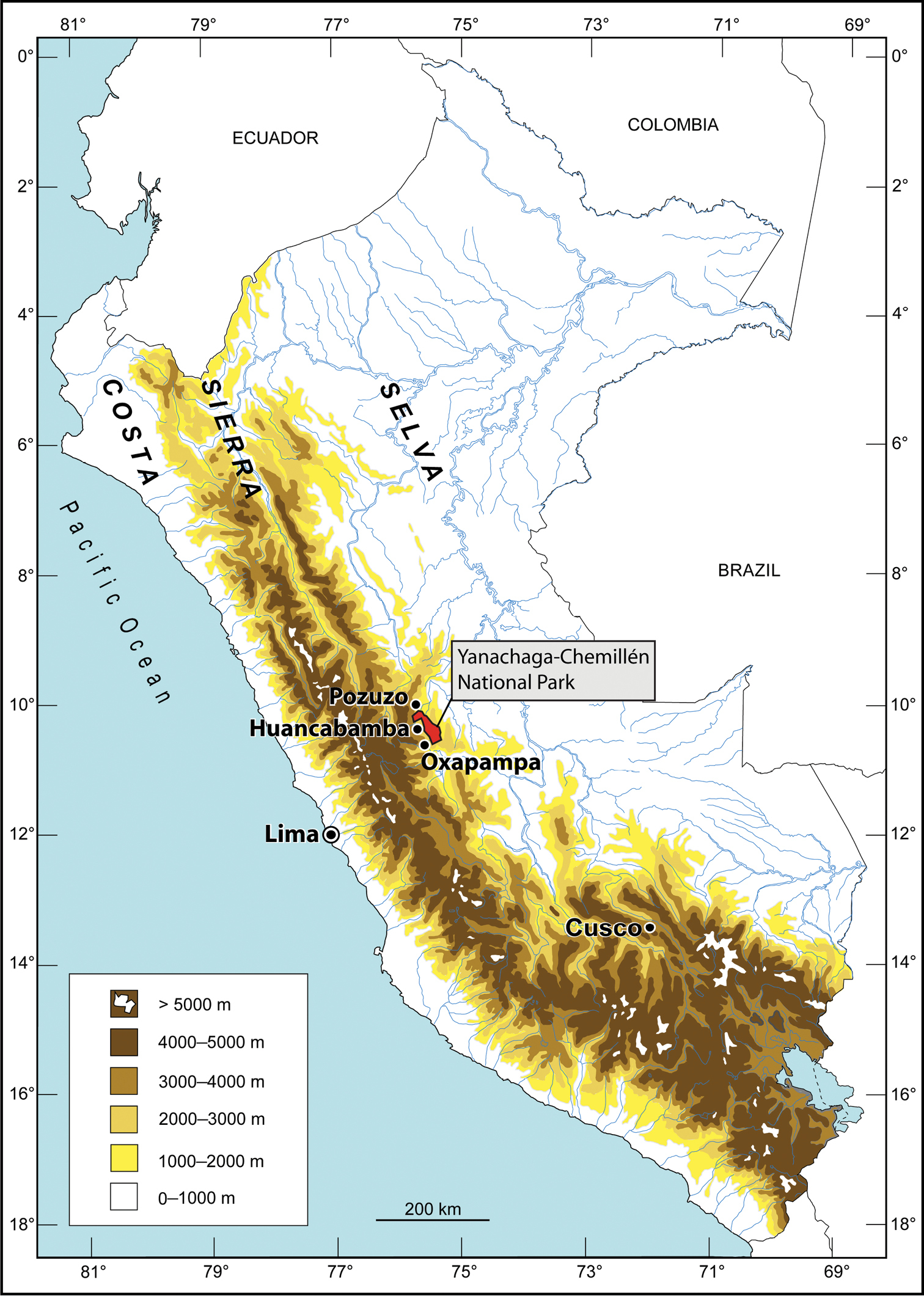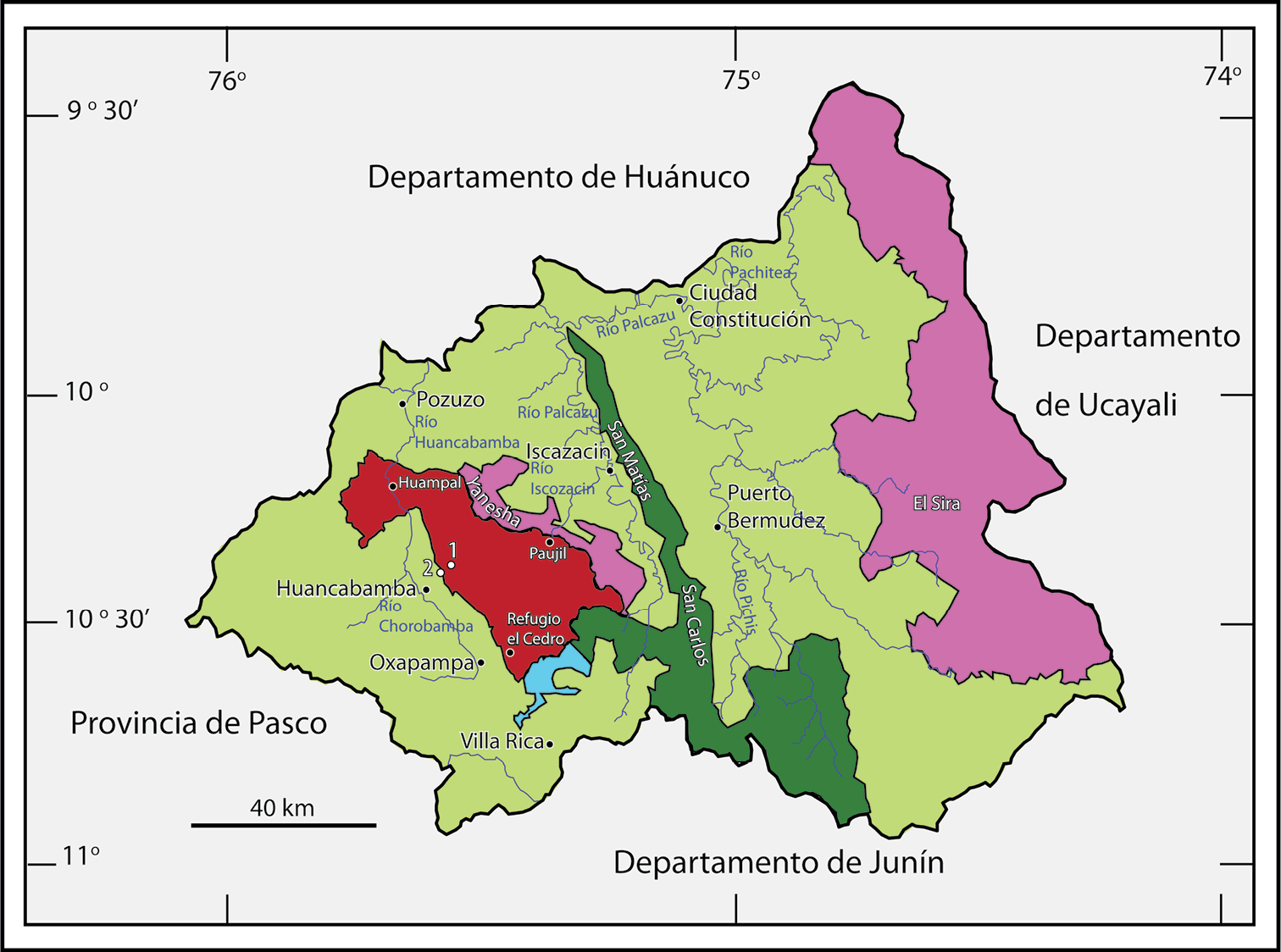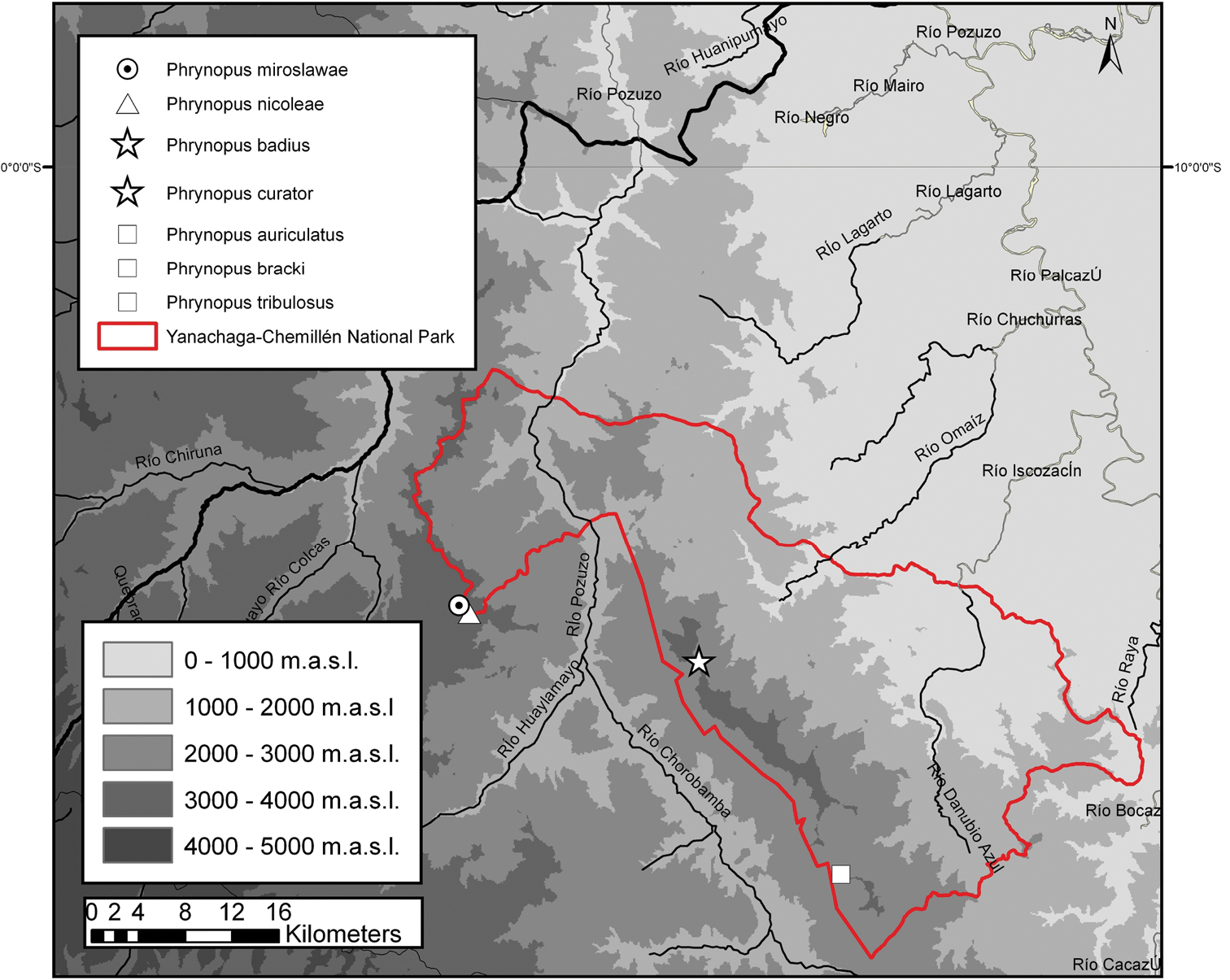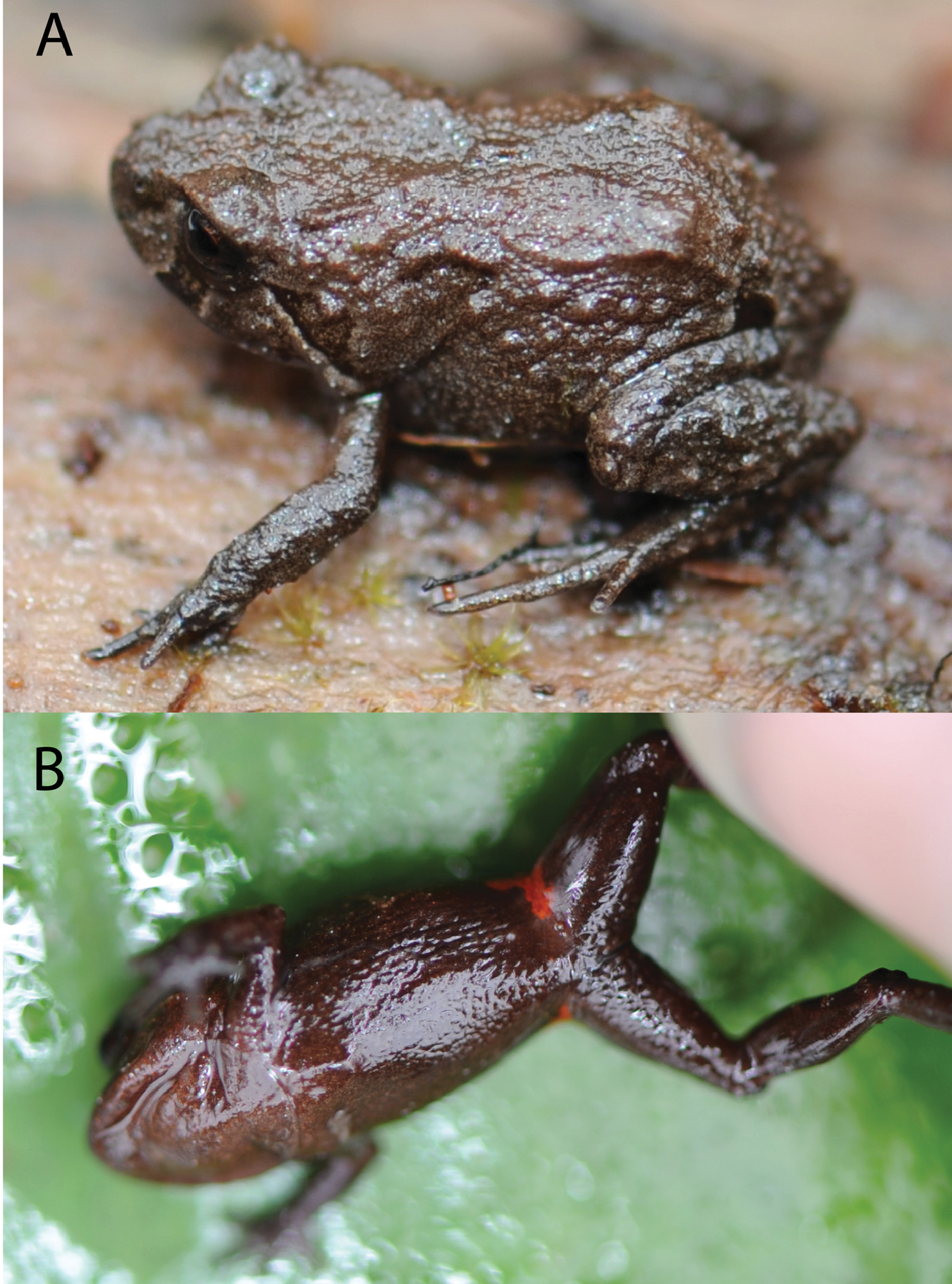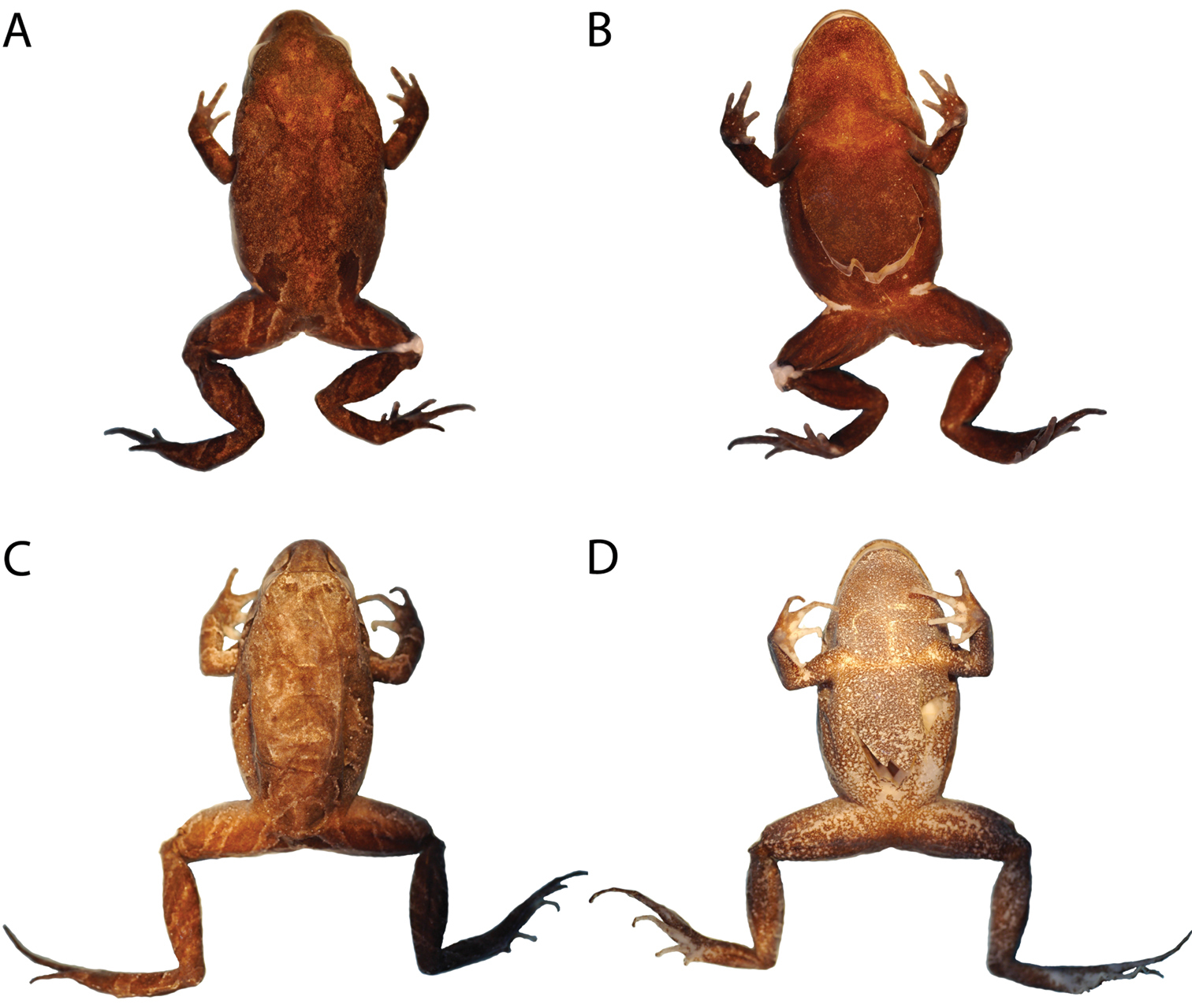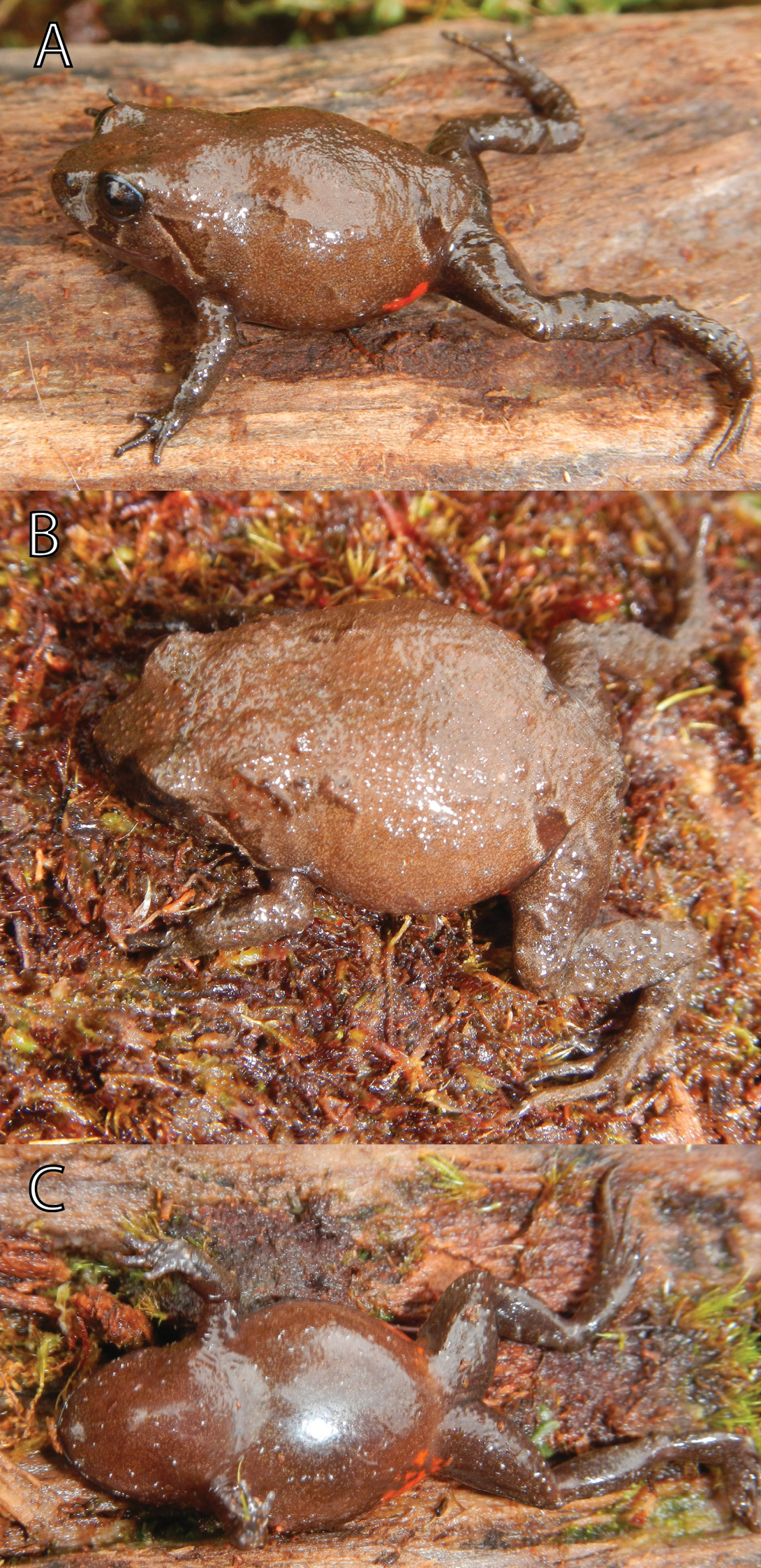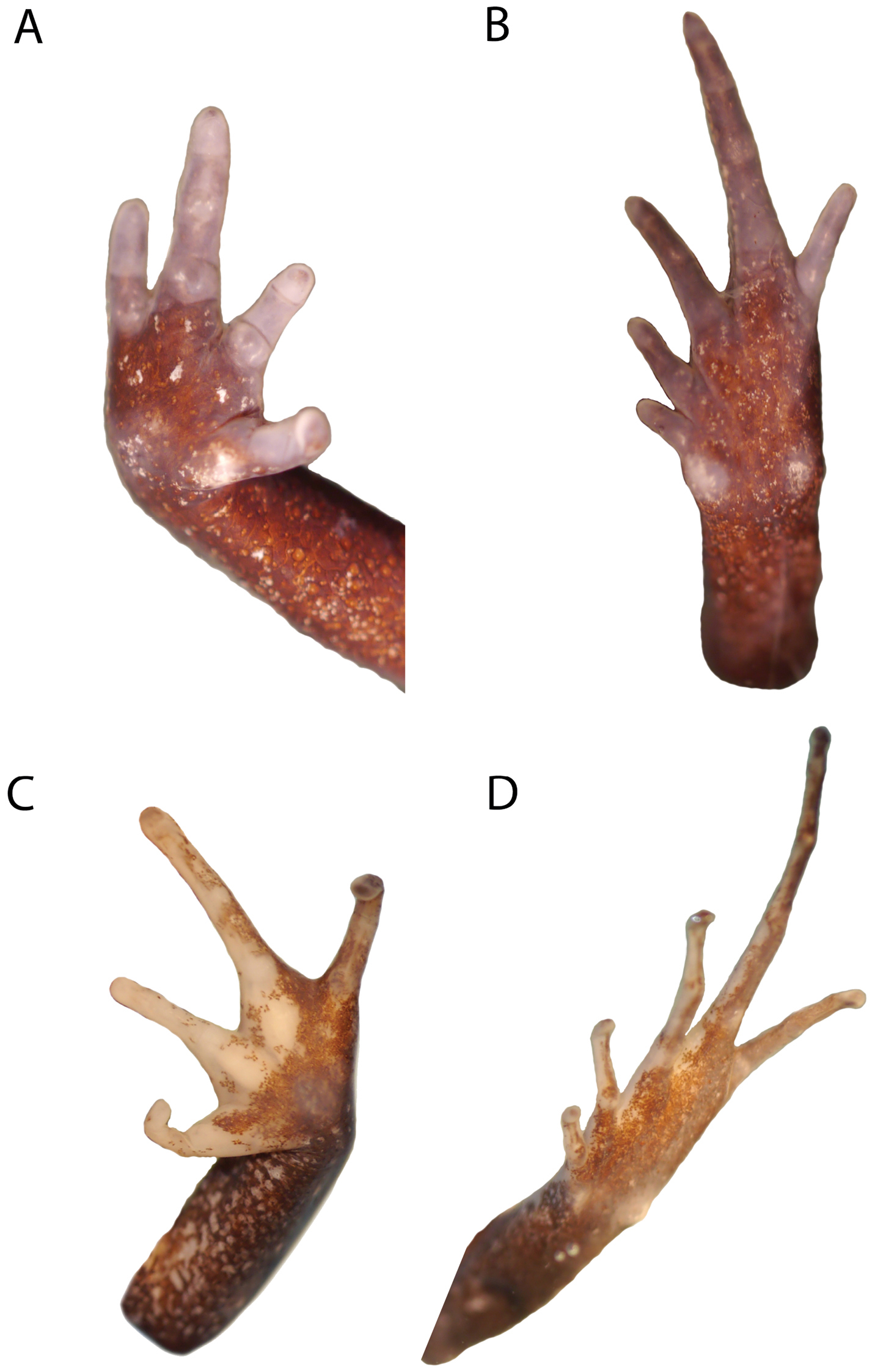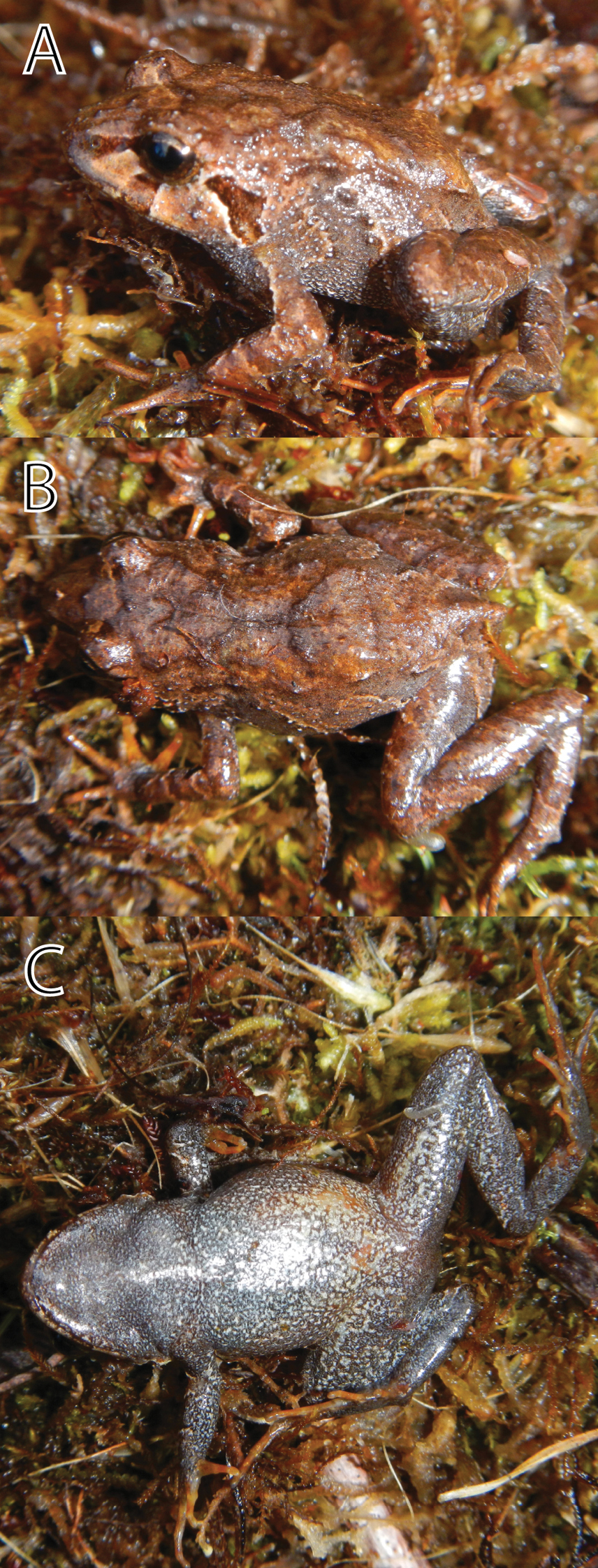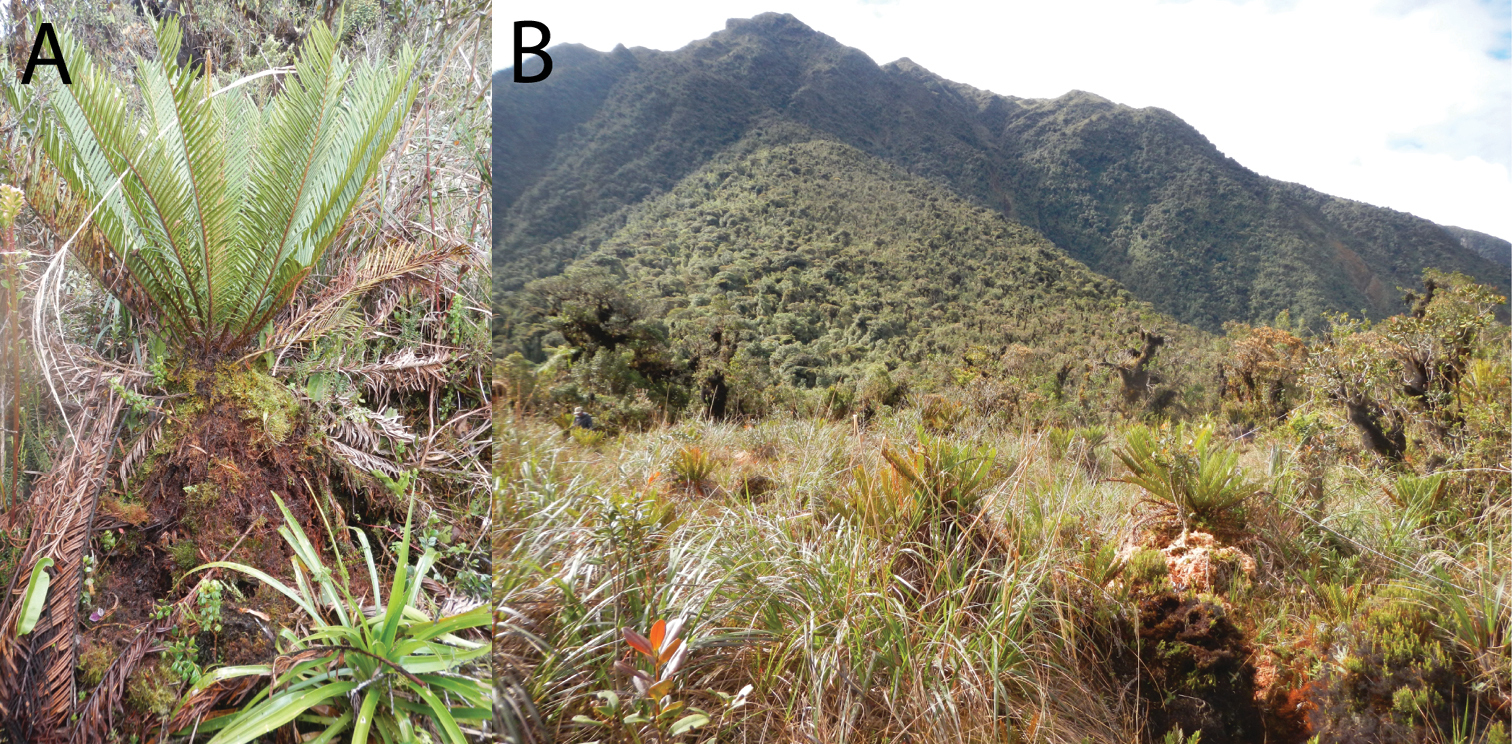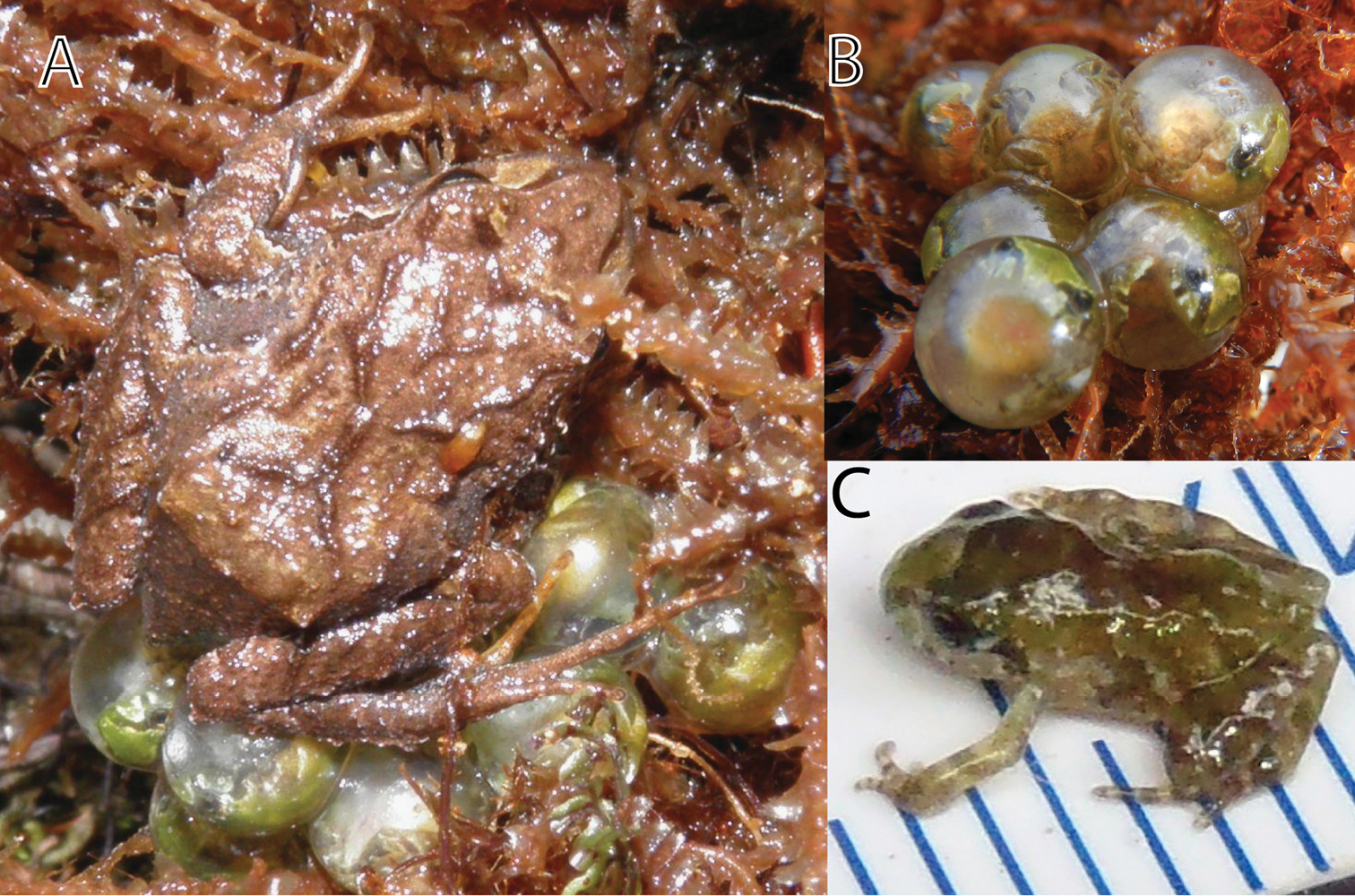






(C) 2012 Edgar Lehr. This is an open access article distributed under the terms of the Creative Commons Attribution License 3.0 (CC-BY), which permits unrestricted use, distribution, and reproduction in any medium, provided the original author and source are credited.
For reference, use of the paginated PDF or printed version of this article is recommended.
We describe two new species of Phrynopus from a cloud forest of the Cordillera Yanachaga, Yanachaga-Chemillén National Park in Peru and describe and document the first clutch and case of parental care for a species of Phrynopus. One of the new species of Phrynopus is described based on two females (SVL 19.1–21.0 mm) which were found in leaf litter and moss layer in a cloud forest at 2900 m elevation. This new species is most similar to Phrynopus bracki. The second new species of Phrynopus was found in the transitional formation between cloud forest and wet puna at 3000 m elevation. Its description is based on a single female (SVL 20.7 mm) that was observed guarding nine eggs under moss. This new species is most similar to Phrynopus nicoleae. The eggs had a diameter of 5.7–5.8 mm (n = 3) and froglets when hatched a SVL of 6.2–6.5 mm (n = 3). Sympatric anurans include Gastrotheca sp., Pristimantis aniptopalmatus, Pristimantis bromeliaceus, Pristimantis sp., and Rhinella yanachaga.
ResumenSe describen dos nuevas especies de Phrynopus procedentes de un bosque nublado de la Cordillera Yanachaga, Parque Nacional Yanachaga-Chemillén, Perú, y se describe y documenta el primer caso de nidada y cuidado parental para una especie de Phrynopus. Una de las nuevas especies de Phrynopus es descrita basándose en dos hembras (Longitud Hocico-Cloaca 19.1–21.0 mm). Los especímenes fueron encontrados en la hojarasca y capa de musgo en un bosque nublado a 2900 m de altitud. Esta especie es muy similar a Phrynopus bracki. La segunda nueva especie de Phrynopus fue encontrada en una formación transicional entre el bosque nublado y la puna humeda a 3000 m de altitud. Su descripción se basa en una sola hembra (Longitud Hocico-Cloaca 20.7 mm) que fue observada protegiendo nueve huevos bajo musgo. Esta especie es muy similar a Phrynopus nicoleae. Los huevos tenían un diámetro de 5.7–5.8 mm (n = 3) y las ranitas cuando eclosionaron tenían una longitud hocico-cloaca de 6.2–6.5 mm (n = 3). Los anuros simpátricos incluyen Gastrotheca sp., Pristimantis aniptopalmatus, Pristimantis bromeliaceus, Pristimantis sp.y Rhinella yanachaga.
Andes, Anura, new species, parental care, Peru, Phrynopus, Strabomantidae
Andes, Anura, cuidado parental, especie nueva, Perú, Phrynopus, Strabomantidae
The Yanachaga-Chemillén National Park (YCNP in the following) is located in the eastern Andes of the poorly explored Pasco department (Figs 1, 2). It was established in 1986 with the aim to protect a unique biodiversity area of the Andean montane cloud forest. Owing a difficult access to the area, the flora and fauna of the YCNP remained mostly unexplored until recently (
Amphibian species described from the YCNP since 1990.
| Family | Species | Publication | Ecoregion |
|---|---|---|---|
| Bufonidae | Rhinella yanachaga |
|
Montane forest (2600 m) |
| Hemiphractidae | Gastrotheca carinaceps |
|
unknown |
| Microhylidae | Melanophryne barbatula |
|
Montane forest (2500 m) |
| Strabomantidae | Phrynopus auriculatus |
|
Montane forest (2600 m) |
| Strabomantidae | Phrynopus badius | This paper | Montane forest (2900 m) |
| Strabomantidae | Phrynopus bracki |
|
Montane forest (2600 m) |
| Strabomantidae | Phrynopus curator | This paper | Montane forest (3000 m) |
| Strabomantidae | Phrynopus miroslawae |
|
Puna (3363 m) |
| Strabomantidae | Phrynopus nicoleae |
|
Puna (3589 m) |
| Strabomantidae | Phrynopus tribulosus |
|
Montane forest (2600) |
| Strabomantidae | Pristimantis albertus |
|
Montane forest (1970 m) |
| Strabomantidae | Phrynopus aniptopalmatus |
|
Montane forest (2300–2600 m) |
| Strabomantidae | Phrynopus bipunctatus |
|
Montane forest (2060–2120 m) |
| Strabomantidae | Phrynopus leucorrhinus |
|
Montane forest (2500 m) |
| Strabomantidae | Phrynopus lucasi |
|
Montane forest (2790 m) |
| Strabomantidae | Phrynopus rhabdocnemus |
|
Montane forest (2600 m) |
| Strabomantidae | Phrynopus stictogaster |
|
Montane forest (2600 m) |
| Strabomantidae | Phrynopus spectabilis |
|
Puna (3300 m) |
Map of Peru with the Yanachaga-Chemillén National Park in red. Map by E. Lehr.
The Yanachaga-Chemillén National Park (in red) with three field stations: Refugio el Cedro at 2400 m, Huampal at 1000 m, and Paujil at 460 m. Other protected areas in the Central Selva region: in pink, Communal Reserves (Yanesha, El Sira); in dark, green Protected Forest (San Matías-San Carlos); and in blue, Municipal Conservation Area (Bosque de Sho’llet). Unprotected Provincial Area is shown in pale green. Collecting sites: 1, Quebrada Yanachaga (2900–3000 m); 2, Huancabamba park entrance (2290–2350 m). Designed by E. Lehr using a template from
Distribution (based on type localities) of the seven species of Phrynopus known from the Yanachaga-Chemillén National Park. Map by J. C. Cusi.
The YCNP (Figs 1–3) covers 1220 km² between 460 and 3643 m elevation and is located at 10°33’37”-17’37”S and 75°30’21”-20’39”W in eastern central Peru (
The Quebrada Yanachaga lies at the southwestern edge of the YCNP (ca. 10-15 km NE from Huancabamba, Fig. 2) at an approximate elevation between 2000 and 3000 m. It is covered by a dense primary montane cloud forest, which changes into more open formation called “pajonal” at the elevation of ca. 2900 m. Quebrada Yanachaga can be reached from Huancabamba taking the road to Prosoya (former Hacienda, see
The format for the description follows
Specimens were deposited in the herpetological collections of the Museo de Historia Natural, Universidad Nacional Mayor de San Marcos (MUSM) in Lima, Peru, and the Field Museum (FMNH) in Chicago. For specimens examined, see Appendix I.
Resultsurn:lsid:zoobank.org:act:DB17180B-BD8F-40AB-80B6-B472E9D29F81
(Figs 4–7) MUSM 31099, an adult gravid female from Quebrada Yanachaga (ca. 10°22.772'S, 75°27.717'W), 2900 m elevation, Yanachaga-Chemillén National Park (Sector San Daniel), Distrito de Huancabamba, Provincia de Oxapampa, Departamento de Pasco, Peru, collected on 19 January 2012 by Edgar Lehr, Jiri Moravec, and Juan Carlos Cusi.
FMNH 282818, an adult, gravid female, collected along with the holotype.
A species of Phrynopus having the following combination of characters: (1) Skin on dorsum shagreen with small scattered tubercles, flanks tuberculate, skin on venter weakly areolate; discoidal fold absent, thoracic fold present; short postocular fold present, elongate tubercles forming discontinous dorsolateral ridges; (2) tympanic membrane and tympanic annulus absent; (3) snout rounded in dorsal and lateral views; (4) upper eyelid without enlarged tubercles; width of upper eyelid narrower than IOD; cranial crests absent; (5) dentigerous processes of vomers absent; (6) condition of vocal slits and nuptial pads unknown (no males found); (7) Finger I shorter than Finger II; tips of digits rounded; (8) fingers without lateral fringes; (9) ulnar and tarsal tubercles absent; (10) heel with minute tubercles; inner tarsal fold absent; (11) inner metatarsal tubercle ovoid, about twice as large as rounded outer metatarsal tubercle; supernumerary plantar tubercles absent; (12) toes without lateral fringes; basal webbing absent; Toe V shorter than Toe III; toe tips rounded (except for slightly pointed Toe IV), about as large as those on fingers; (13) in life, dorsum reddish brown or dark grayish brown, venter dark brown with scattered minute white dots, groin dark brown with bright orange flecks on its lower half and a dark brown inguinal bar on its upper half; (14) SVL in females 19.1–21.0 mm (n = 2).
The assignment of the new species to Phrynopus is based on the structure of the digital discs that lack circumferential groves as well as the overall morphological similarity with the other members of the genus. Phrynopus badius is readily distinguished from its congeners by its small size, by having discontinuous dorsolateral ridges, and by having the dorsum reddish brown or dark grayish brown and the venter dark brown with scattered minute white dots, groin dark brown with bright orange flecks on its lower half and a dark brown inguinal bar on its upper half.
Furthermore Phrynopus badius differs from those species of Phrynopus (auriculatus, montium, peruanus) that have a tympanum (absent in Phrynopus badius), and from those species (dagmarae, horstpauli, kotosh, miroslawae, nicoleae, vestigiatus) that have dentigerous processes of vomers (absent in Phrynopus badius). Phrynopus badius shares with eight other species of Phrynopus (bracki, dagmarae, heimorum, interstinctus, nicoleae, paucari, peruanus, vestigiatus) an aposematic coloration consisting of red, orange, salmon or flesh coloured blotches in the groin. However, none of these species has the venter dark brown with scattered minute white dots, groin dark brown with bright orange flecks on its lower half, and a dark brown inguinal bar on its upper half.
Six other species of Phrynopus have been recorded from the YCNP. Those are Phrynopus auriculatus (
Head narrower than body, slightly wider than long, HW 101.2% of HL; HW 34.0% of SVL; HL 33.5% of SVL; snout short, rounded in dorsal and lateral views (Figs 4, 5), ED larger than E-N distance; nostrils protuberant, directed dorsolaterally; canthus rostralis short, slightly concave in dorsal view, rounded in profile; loreal region slightly concave; lips rounded; upper eyelid without enlarged tubercles; EW narrower than IOD (EW 60.9% of IOD); supratympanic fold short and low, extending from posterior corner of eye to level of jaw articulation, barely distinguishable in preservation; tympanic membrane and tympanic annulus absent; postrictal tubercles indistinguishable from surrounding tuberculation. Choanae small, ovoid, not concealed by palatal shelf of maxilla; dentigerous processes of vomers absent; tongue narrow and long, much longer than wide, not notched posteriorly, posterior half free.
Skin on dorsum shagreen with small scattered tubercles, short postocular fold present, elongate tubercles forming discontinuous dorsolateral ridges; skin on flanks tuberculate; skin on throat smooth, that on chest and belly weakly areolate; discoidal fold absent, thoracic fold present; cloacal sheath short; large tubercles absent in cloacal region. Outer surface of forearm without minute tubercles; outer and inner palmar tubercles low, ovoid, outer about twice the size of inner palmar tubercle; supernumerary tubercles indistinct in preservative; subarticular tubercles low, barely discernible except for prominent, ovoid subarticular tubercles on base of fingers; fingers without lateral fringes; Finger I shorter than Finger II; tips of digits rounded, lacking marginal grooves (Fig. 7A).
Hind limbs short and robust, TL 37.2% of SVL; FL 41.4.9% of SVL; upper surface of hind limbs tuberculate; posterior and ventral surfaces of thighs areolate; heel with minute tubercles; outer surface of tarsus with small tubercles; inner metatarsal tubercle ovoid, about twice as large as rounded outer metatarsal tubercle; supernumerary plantar tubercles absent; subarticular tubercles low, ovoid in dorsal view; toes without lateral fringes; basal webbing absent; toe tips rounded (except for pointed tip of Toe IV), lacking marginal grooves, about as large as those on fingers; relative lengths of toes: 1 < 2 < 3 > 5 < 4; Toe V shorter than Toe III, Toe I less than half the size of Toe II (Fig. 7B).
Measurements (in mm) of holotype:SVL 19.1; TL 7.1; FL 7.9; HL 6.4; HW 6.5; ED 2.1; IOD 2.3; EW 1.4; IND 1.9; E-N 1.5.
(Fig. 4): Dorsum dark grayish brown with white dots and reddish brown mottling; narrow, dark brown interorbital bar and a dark brown blotch on each side in the scapular region; dorsal surface of forearms with a dark brown bar; hind legs each with three dark brown diagonal stripes; ill-defined dark brown canthal stripe, supratympanic stripe broad, dark brown and outlined by tan; broad, dark brown bar on upper lip below eye bordered by narrow, tan stripe on each side; flanks coloured as dorsum with broad diagonal stripe at the anterior half; axilla dark brown with a small orange fleck; groin dark brown with orange flecks on its lower half and a dark inguinal bar on its upper half extending onto dorsal surface of thigh; posterior surfaces of thighs and concealed surfaces of shanks dark brown with few white dots; throat reddish brown with white dots; chest, belly, and extremities dark brown with white dots; fingers and toes gray, palmar and plantar surfaces gray with white mottling; iris predominately black with fine bronze reticulations and red ringlet around pupil.
(Figs 5A, B): As described above but slightly paler and orange coloration being white; iris gray.
The female paratype (Fig. 6) is larger than the holotype, less tuberculate, and has elongate tubercles forming ill-defined dorsolateral ridges restricted to the anterior half of its body. The overall coloration pattern is similar to the holotype, however the dorsal coloration is reddish brown, the venter has more white dots and the groin has more orange flecks.
Measurements (in mm) of female (FMNH 282818): SVL 21.0; TL 7.5; FL 8.5; HL 7.0; HW 7.6; ED 2.3; IOD 2.4; EW 1.4; IND 1.9; E-N 1.7.
The specific name badius is the Latin adjective meaning chestnut-brown or reddish-brown and refers to the coloration of the new species.
The species is only known from the type locality where it was found at 1.00 pm in the leaf litter and under moss in a primary cloud forest at 2900 m elevation. The axilla region of the left arm of the paratype bears two ectoparasites (mites). Syntopic anurans include Rhinella yanachaga (MUSM 31100, FMNH 282819) which is recorded herein for the first time outside its type locality of San Alberto (
Holotype of Phrynopus badius in life (MUSM 31099, female, SVL 19.1 mm) in lateral (A), and ventral views (B). Photos by E. Lehr.
Holotype of Phrynopus badius in preservative in dorsal (A), and ventral (B) views, and holotype of Phrynopus curator in dorsal (C), and ventral (D) views. Photos by E. Lehr.
Paratype of Phrynopus badius in life (FMNH 282818, female, SVL 21.0 mm) in lateral (A), dorsal (B), and ventral (C) views. Photos by E. Lehr.
Photos of ventral surfaces of hand (A) and foot (B) of Phrynopus badius (MUSM 31099), and ventral surfaces of hand (C) and foot (D) of Phrynopus curator (MUSM 31106). Photos by E. Lehr.
urn:lsid:zoobank.org:act:E64899F5-B179-4A45-8E8A-CD6D8BB977ED
(Figs 5, 7, 8, 10) MUSM 31106, an adult, gravid female, from Quebrada Yanachaga (10°22.772'S, 75°27.717'W), 3000 m elevation, Yanachaga-Chemillén National Park (Sector San Daniel), Distrito de Huancabamba, Provincia de Oxapampa, Departamento de Pasco, Peru, collected on 20 January 2012 by Edgar Lehr, Jiri Moravec, and Juan Carlos Cusi.
(Fig. 10C) FMNH 282820-22, three hatchlings, collected as eggs with the holotype.
A species of Phrynopus having the following combination of characters: (1) Skin on dorsum shagreen with small scattered tubercles, prominent ridges, and two prominent middorsal Y-shaped ridges, flanks shagreen with small scattered tubercles, skin on venter weakly areolate; discoidal fold absent, weak thoracic fold present; ridges forming discontinuous dorsolateral fold; (2) tympanic membrane and tympanic annulus absent; (3) snout rounded in dorsal and lateral views; (4) upper eyelid with three enlarged tubercles; width of upper eyelid narrower than IOD; cranial crests absent; (5) dentigerous processes of vomers absent; (6) condition of vocal slits and nuptial pads unknown (no males found); (7) Finger I shorter than Finger II; tips of digits rounded; (8) fingers without lateral fringes; (9) ulnar and tarsal tubercles absent; (10) heel with a distinct conical tubercle; inner tarsal fold absent; (11) outer metatarsal tubercle rounded, about twice as large as ovoid inner metatarsal tubercle; supernumerary plantar tubercles absent; (12) toes without lateral fringes; basal webbing absent; Toe V slightly shorter than Toe III; toe tips rounded, about as large as those on fingers; (13) in life, dorsum reddish brown with dark gray and yellowish-brown mottling, venter gray with pale gray mottling and brownish-cream flecks around posterior half of belly, groin brown and gray mottled; (14) SVL in single female 20.7 mm.
The assignment of the new species to Phrynopus is based on the structure of the digital discs that lack circumferential groves as well as the overall morphological similarity with the other members of the genus. Phrynopus curator is readily distinguished from its congeners by having the dorsum with prominent middorsal Y-shaped ridges, a conical heel tubercle, absence of dentigerous processes of vomers, and a gray venter with pale gray mottling.
Furthermore Phrynopus curator differs from those species of Phrynopus (auriculatus, montium, and peruanus) that have a tympanum (absent in Phrynopus curator), and from those species (dagmarae, horstpauli, kotosh, miroslawae, nicoleae, and vestigiatus) that have dentigerous processes of vomers (absent in Phrynopus curator). Phrynopus curator lacks an aposematic coloration consisting of red, orange, salmon or flesh colored blotches in the groin (present in badius, bracki, dagmarae, heimorum, interstinctus, nicoleae, paucari, peruanus, and vestigiatus).
Six other species of Phrynopus have been recorded from the YCNP. Those are Phrynopus auriculatus (
Head narrower than body, slightly longer than wide, HW 98.6% of HL; HW 33.8% of SVL; HL 33.3% of SVL; snout moderately long, rounded in dorsal and lateral views (Figs 5, 8), ED larger than E-N distance; nostrils not protuberant, directed dorsolaterally; canthus rostralis short, straight in dorsal view, rounded in profile; loreal region slightly concave; lips rounded; upper eyelid without enlarged tubercles; EW narrower than IOD (EW 82.6% of IOD); supratympanic fold short and low, extending from posterior corner of eye to level of jaw articulation, barely distinguishable in preservation; tympanic membrane and tympanic annulus absent; minute postrictal tubercles. Choanae small, ovoid, not concealed by palatal shelf of maxilla; dentigerous processes of vomers absent; tongue broad, longer than wide, not notched posteriorly, posterior one third free.
Skin on dorsum shagreen with small scattered tubercles, prominent ridges, and two prominent middorsal Y-shaped ridges connected at their bases; postocular folds short, ridges forming discontinuous dorsolateral fold; skin on flanks shagreen with small scattered tubercles, skin on throat smooth, skin on chest and belly weakly areolate; discoidal fold absent, weak thoracic fold present; cloacal sheath short; large tubercles absent in cloacal region. Outer surface of forearm without minute tubercles; outer palmar tubercle bifid, low, ovoid, about twice the size of ovoid inner palmar tubercle; supernumerary tubercles indistinct in preservative; subarticular tubercles low, ovoid, most prominent on base of fingers; fingers without lateral fringes; Finger I shorter than Finger II; tips of digits rounded, lacking marginal grooves (Fig. 7C).
Hind limbs long and slim, TL 49.3% of SVL; FL 49.8% of SVL; upper surface of hind limbs tuberculate with narrow diagonal ridges (Fig. 10A); posterior and ventral surfaces of thighs areolate; heel with a distinct conical tubercle; outer surface of tarsus with small tubercles; outer metatarsal tubercle round, about twice as large as ovoid inner metatarsal tubercle; supernumerary plantar tubercles indistinct in preservative; subarticular tubercles low, ovoid in dorsal view, most distinct on base of toes; toes without lateral fringes; basal webbing absent; toe tips rounded, lacking marginal grooves, about as large as those on fingers; relative lengths of toes: 1 < 2 < 3 > 5 < 4; Toe V shorter than Toe III (Fig. 7D).
Measurements (in mm) of holotype:SVL 20.7; TL 10.2; FL 10.3; HL 6.9; HW 7.0; ED 2.4; IOD 2.3; EW 1.9; IND 2.1; E-N 1.8.
(Fig. 8): Dorsum reddish brown with dark gray and yellowish-brown mottling, and few white tubercles; dark brown interorbital bar bordered anteriorly with a narrow yellowish-brown stripe; dorsal surface of forearms and hind legs with diagonal dark brown bars outlined with pale grayish-brown stripes; dark brown canthal stripe; broad, dark brown supratympanic stripe outlined by tan; broad, dark brown bar on upper lip below eye, bordered by narrow, tan stripe on each side; flanks colored as dorsum with a broad gray diagonal stripe at the anterior half, bordered on both sides with a narrow tan stripe; axilla and groin brown and gray mottled; gray inguinal bar bordered on both sides with a narrow tan stripe extending onto dorsal surface of thigh; posterior surfaces of thighs and concealed surfaces of shanks brown and gray mottled; throat gray with pale gray mottling; chest, belly, and extremities gray with pale gray dots and flecks; outer fingers and outer toes yellowish brown, palmar and plantar surfaces dark gray; iris predominately reddish brown with fine black reticulations and golden ringlet around pupil.
(Figs 5C, D): As described above but slightly paler with gray coloration being brown and yellowish brown being white; iris gray.
Freshly hatched froglets (FMNH 282820-22) had a SVL of 6.2–6.5 mm (n = 3). Froglets were pale green with brown blotches on dorsum, brown canthal and supratympanic stripes, brown bars on upper lip, and distinct diagonal brown stripe on flanks and on extremities (Fig. 10C), all brown bars and stripes bordered with white stripes.
The specific name curator is the Latin noun meaning caretaker and refers to the observed behaviour of the female guarding nine terrestrial eggs.
The species is only known from the type locality (a summit of a mountain ridge of Cordillera Yanachaga, 3000 m). The habitat consisted of transitional formation between cloud forest and wet puna. The type locality is a slightly swampy plain covered by scattered bushes, small isolated trees, ferns, moss, and lichens (Fig. 9). The single specimen was found at 3.30 pm under a moss layer at approx. 10–15 cm depth covering the stem of a fern. The female was gravid (small unpigmented eggs) and guarding a clutch consisting of nine terrestrial eggs and was partially sitting on them (Fig. 10A). Young frogs (Fig. 10B) were clearly visible based on their pale green coloration and moved inside the eggs when being disturbed. The eggs had a diameter of 5.7–5.8 mm (n = 3). Two days after collection of three eggs three froglets hatched. Phrynopus curator called from under moss during the day. Sympatric anurans include Gastrotheca sp. (heard call), Pristimantis aniptopalmatus, Pristimantis bromeliaceus and Pristimantis sp. We classify Phrynopus curator as “Data Deficient” according to the IUCN red list criteria and categories based on the limited information on its geographic range.
Holotype of Phrynopus curator in life (MUSM 31106, female, SVL 20.7 mm) in lateral (A), dorsal (B), and ventral views (C). Photos by E. Lehr.
Habitat of Phrynopus curator. Fern where Phrynopus curator and clutch were found (A) on pampa of Quebrada Yanachaga at 3000 m elevation (B). Photos by E. Lehr.
Phrynopus curator (MUSM 31106) guarding eggs (A), eggs (B) and hatchling (FMNH 282820-22) with scale in mm (C). Photos by J. Moravec (A, C) and E. Lehr (B).
Despite the limited number of specimens of Phrynopus badius and Phrynopus curator both species are morphologically clearly differentiated from all other known species of Phrynopus which justifies their description. Calling males of both species were heard by day in leaf litter and moss layer. However, despite our efforts males were not located in the dense vegetation. Both species of Phrynopus occupy different habitats. Whereas Phrynopus badius was found on the steep mountain slopes under closed canopy of cloud forest, Phrynopus curator inhabited moss layers in open transitional area between cloud forest and wet puna. Both species seem to display a dissimilar adaptation to different habitat conditions. Phrynopus badius has shorter legs (holotype TL 37.2% of SVL, paratype TL 35.7% of SVL) and moves by walking or short jumps. On the contrary, Phrynopus curator has longer legs (TL 49.3% of SVL), fingers and toes, is more agile and jumps readily if disturbed.
With Phrynopus curator we describe and document the first clutch and case of parental care for a species of Phrynopus. A previous report of parental care was provided by
New species of Phrynopus are frequently discovered when field work is conducted in cloud forests and puna regions in central Peru (e.g.
We thank the associate editor Franco Andreone and one anonymous reviewer for their helpful comments and suggestions. Specimens were loaned by J. Córdova (MUSM). We thank M. Schlegel (PROSOYA, Huancabamba) for assistance in the field. EL thanks IWU for a junior faculty leave to conduct this fieldwork. We thank the Ministerio del Ambiente for collecting and export permits. P. Carrillo and V. Canales encouraged EL to conduct fieldwork in the YCNP and helped to obtain collecting permits. Special thanks go to R. Vasques (Missouri Botanical Garden, Oxapampa) for providing us with valuable information and literature about the national park. The work of J.M. was supported financially by the Ministry of Culture of the Czech Republic (DKRVO National Museum Prague).
Specimens examined
Phrynopus bracki: PERU: Pasco: Pasco: Parque de la Nación Yanachaga-Chemillén, 2600 m: MUSM 4400 (paratype); Parque de la Nación Yanachaga-Chemillén: San Alberto: MUSM 19906–08.
Phrynopus dagmarae: PERU: Huánuco: Palma Pampa, 3020 m: MUSM 20451 (holotype).
Phrynopus horstpauli: PERU: Huánuco: Ichocan, Jatunloma-forest, 3100 m: MTD 44333–39.
Phrynopus interstinctus: PERU: Húánuco: Cordillera de Carpish, San Marcos, 3100 m: MUSM 29543 (holotype), 3160 m: MUSM 29544–29545 (paratypes).
Phrynopus peruanus: PERU: Junín: Puna of Maraynioc (11°21'35.2"S, 75°28'52.6"W), 3825 m: MUSM 19977–78.
Phrynopus vestigiatus: PERU: Húánuco: Cordillera de Carpish, San Pedro de Carpish, 3100 m: MUSM 29542 (holotype).
